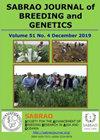REFORESTATION POTENTIAL OF TUGAI FORESTS IN THE FLOODPLAINS OF SYR DARYA AND ILI RIVERS IN THE TERRITORY OF KAZAKHSTAN
IF 1.6
Q3 PLANT SCIENCES
引用次数: 0
Abstract
In the present era, assumptions on tugai forests consist of a complex floodplain ecosystem (reed-cattail thickets, gallery forests, halophytic shrubs, and grass biocenoses) of various ecological levels located from the water’s edge to the upper floodplains and riverine shafts. Anthropogenic transformations disrupted the natural dynamics of the tugai ecosystem. The presented study sought to characterize the current state of tugai forests in different regions of Kazakhstan to conduct monitoring of forest entomology and determine the reforestation potential of tugai plants in the floodplains of the Syr Darya and Ili rivers of Kazakhstan. The recent work focused on vital aspects associated with reinstating tugai forests. Special monitoring of forest pests progressed for the timely detection of their reproduction bulk, foci development, and plan extinction measures. The forest entomology monitoring results revealed the destruction of plants due to leaf-gnawing and gall-forming insect pests. A laid out 27 test areas investigated the dynamics of the undergrowth in tugai forests. The reproductive capacity of the plants, viz., Populus diversifolia, Elaeágnus angustifólia, Sálix acutifólia, and Salix wilhelmsiana, attained evaluation. Natural renaissance under the main forest-forming rocks’ characterization in tugai plantations was good.哈萨克斯坦境内锡尔河和伊犁河泛滥平原土盖森林的再造林潜力
在当今时代,土盖森林的假设包括一个复杂的洪泛区生态系统(芦苇-香蒲灌丛、廊道林、盐生灌木和草类生物群落),从水边到上游洪泛区和河流竖井,具有不同的生态水平。人为的变化破坏了土改生态系统的自然动态。本研究旨在描述哈萨克斯坦不同地区土盖森林的现状,以便进行森林昆虫学监测,并确定哈萨克斯坦锡尔河和伊犁河泛滥平原土盖植物的再造林潜力。最近的工作集中在与恢复土盖森林有关的重要方面。开展森林害虫专项监测工作,及时发现森林害虫的繁殖数量、疫源地发展情况,制定灭杀措施。森林昆虫学监测结果显示,植物因啃叶和成瘿害虫而遭受破坏。通过布置27个试验区,对土改森林林下植被动态进行了研究。对杨树、Elaeágnus angustifólia、Sálix acutifólia和柳树的繁殖能力进行了评价。土改人工林主要造林岩特征下的自然复兴表现良好。
本文章由计算机程序翻译,如有差异,请以英文原文为准。
求助全文
约1分钟内获得全文
求助全文
来源期刊

Sabrao Journal of Breeding and Genetics
农林科学-奶制品与动物科学
CiteScore
1.90
自引率
50.00%
发文量
63
期刊介绍:
The SABRAO Journal of Breeding and Genetics is an international journal of plant breeding and genetics research and was first published in 1969. It is the official publication of the Society for the Advancement of Breeding Research in Asia and Oceania (SABRAO).
Its objectives are to: promote the international exchange of research information on plant breeding and genetics, by describing new research findings, or ideas of a basic or practical nature; and be a medium for the exchange of ideas and news regarding members of the Society.
The Journal gives priority to articles that are of direct relevance to plant breeders and with emphasis on the Asian region. Invited for publication are research articles, short communications, methods, reviews, commentaries, and opinion articles. Scientific contributions are refereed and edited to international standards.
The journal publishes articles for SABRAO members mainly. The Journal preferred strongly that at least one author should be a current member of the Society. Non-members may also publish in the journal.
 求助内容:
求助内容: 应助结果提醒方式:
应助结果提醒方式:


